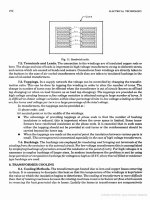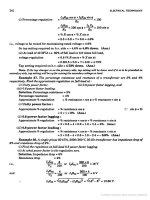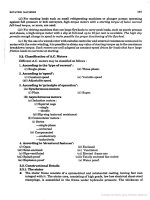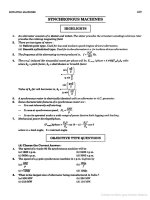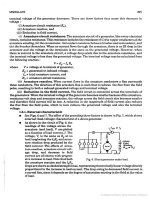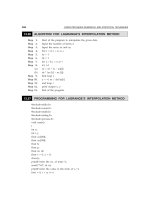A textbook of physical chemistry dynamics of chemical reactions, statistical thermodynamics and macromolecules (SI unit), 3e, volume 5
Bạn đang xem bản rút gọn của tài liệu. Xem và tải ngay bản đầy đủ của tài liệu tại đây (39.63 MB, 559 trang )
A Textbook of
Physical Chemistry
Volume V
www.pdfgrip.com
A Textbook of Physical Chemistry
Volume
Volume
Volume
Volume
Volume
I
II
III
IV
V
:
:
:
:
:
States of Matter and Ions in Solution
Thermodynamics and Chemical Equilibrium
Applications of Thermodynamics
Quantum Chemistry and Molecular Spectroscopy
Dynamics of Chemical Reactions, Statistical Thermodynamics, Macromolecules, and
Irreversible Processes
Volume VI : Computational Aspects in Physical Chemistry
www.pdfgrip.com
A Textbook of
Physical Chemistry
Volume V
(SI Units)
Dynamics of Chemical Reactions, Statistical Thermodynamics,
Macromolecules and Irreversible Processes
Third Edition
k l kAPoor
Former Associate Professor
Hindu College
University of Delhi
New Delhi
McGraw Hill Education (India) Private Limited
New Delhi
McGraw Hill Education Offices
New Delhi New York St louis San Francisco Auckland Bogotá Caracas
Kuala lumpur lisbon london Madrid Mexico City Milan Montreal
San Juan Santiago Singapore Sydney Tokyo Toronto
www.pdfgrip.com
Published by McGraw Hill Education (India) Private Limited,
P-24, Green Park Extension, New Delhi 110 016.
A Textbook of Physical Chemistry, Vol V
Copyright © 2015 by McGraw Hill Education (India) Private Limited.
No part of this publication may be reproduced or distributed in any form or by any means, electronic, mechanical, photocopying, recording, or otherwise or stored in a database or retrieval system without the prior written permission of the
publishers. The program listings (if any) may be entered, stored and executed in a computer system, but they may not be
reproduced for publication.
This edition can be exported from India only by the publishers,
McGraw Hill Education (India) Private Limited.
Print Edition
ISBN (13): 978-93-39204-31-0
ISBN (10): 93-39204-31-X
E-book Edition
ISBN (13): 978-93-392-0432-7
ISBN (10): 93-392-0432-8
Managing Director: Kaushik Bellani
Head—Higher Education (Publishing and Marketing): Vibha Mahajan
Senior Publishing Manager (SEM & Tech. Ed.): Shalini Jha
Associate Sponsoring Editor: Smruti Snigdha
Senior Editorial Researcher: Amiya Mahapatra
Senior Development Editor: Renu Upadhyay
Manager—Production Systems: Satinder S Baveja
Assistant Manager—Editorial Services : Sohini Mukherjee
Assistant General Manager (Marketing)—Higher Education: Vijay Sarathi
Senior Graphic Designer—Cover: Meenu Raghav
General Manager—Production: Rajender P Ghansela
Manager—Production: Reji Kumar
Information contained in this work has been obtained by McGraw Hill Education (India), from sources believed to
be reliable. However, neither McGraw Hill Education (India) nor its authors guarantee the accuracy or completeness
of any information published herein, and neither McGraw Hill Education (India) nor its authors shall be responsible
for any errors, omissions, or damages arising out of use of this information. This work is published with the
understanding that McGraw Hill Education (India) and its authors are supplying information but are not attempting
to render engineering or other professional services. If such services are required, the assistance of an appropriate
professional should be sought.
Typeset at Script Makers, 19, A1-B, DDA Market, Paschim Vihar, New Delhi 110 063, and text printed at
www.pdfgrip.com
To the Memory of My Parnets
www.pdfgrip.com
www.pdfgrip.com
Preface
in recent years, the teaching curriculum of Physical Chemistry in many indian
universities has been restructured with a greater emphasis on a theoretical and
conceptual methodology and the applications of the underlying basic concepts and
principles. This shift in the emphasis, as i have observed, has unduly frightened
undergraduates whose performance in Physical Chemistry has been otherwise
generally far from satisfactory. This poor performance is partly because of the
non-availability of a comprehensive textbook which also lays adequate stress on
the logical deduction and solution of numericals and related problems. Naturally,
the students find themselves unduly constrained when they are forced to refer to
various books to collect the necessary reading material.
it is primarily to help these students that i have ventured to present a textbook
which provides a systematic and comprehensive coverage of the theory as well as
of the illustration of the applications thereof.
The present volumes grew out of more than a decade of classroom teaching
through lecture notes and assignments prepared for my students of BSc (General)
and BSc (honours). The schematic structure of the book is assigned to cover
the major topics of Physical Chemistry in six different volumes. Volume I
discusses the states of matter and ions in solutions. It comprises five chapters
on the gaseous state, physical properties of liquids, solid state, ionic equilibria
and conductance. Volume II describes the basic principles of thermodynamics
and chemical equilibrium in seven chapters, viz., introduction and mathematical
background, zeroth and first laws of thermodynamics, thermochemistry, second
law of thermodynamics, criteria for equilibrium and A and G functions, systems
of variable composition, and thermodynamics of chemical reactions. Volume III
seeks to present the applications of thermodynamics to the equilibria between
phases, colligative properties, phase rule, solutions, phase diagrams of one-,
two- and three-component systems, and electrochemical cells. Volume IV deals
with quantum chemistry, molecular spectroscopy and applications of molecular
symmetry. it focuses on atomic structure, chemical bonding, electrical and
magnetic properties, molecular spectroscopy and applications of molecular
symmetry. Volume V covers dynamics of chemical reactions, statistical and
irreversible thermodynamics, and macromolecules in six chapters, viz., adsorption,
chemical kinetics, photochemistry, statistical thermodynamics, macromolecules
and introduction to irreversible processes. Volume VI describes computational
aspects in physical chemistry in three chapters, viz., synopsis of commonly used
statements in BASiC language, list of programs, and projects.
The study of Physical Chemistry is incomplete if students confine themselves
to the ambit of theoretical discussions of the subject. They must grasp the practical
significance of the basic theory in all its ramifications and develop a clear
perspective to appreciate various problems and how they can be solved.
www.pdfgrip.com
it is here that these volumes merit mention. Apart from having a lucid style
and simplicity of expression, each has a wealth of carefully selected examples and
solved illustrations. Further, three types of problems with different objectives in
view are listed at the end of each chapter: (1) Revisionary Problems, (2) Try Yourself
Problems, and (3) Numerical Problems. Under Revisionary Problems, only those
problems pertaining to the text are included which should afford an opportunity to
the students in self-evaluation. in Try Yourself Problems, the problems related to
the text but not highlighted therein are provided. Such problems will help students
extend their knowledge of the chapter to closely related problems. Finally, unsolved
Numerical Problems are pieced together for students to practice.
Though the volumes are written on the basis of the syllabi prescribed for
undergraduate courses of the University of Delhi, they will also prove useful to
students of other universities, since the content of physical chemistry remains the
same everywhere. in general, the Si units (Systeme International d’ unite’s), along
with some of the common non-Si units such as atm, mmhg, etc., have been used
in the books.
Salient Features
∑
Comprehensive coverage to adsorption, chemical kinetics, photochemistry,
statistical thermodynamics, macromolecules
∑
emphasis given to applications and principles
∑
explanation of equations in the form of solved problems and numericals
∑
iUPAC recommendations and Si units have been adopted throughout.
∑
Rich and illustrious pedagogy
Acknowledgements
i wish to acknowledge my greatest indebtedness to my teacher, late Prof. R P
Mitra, who instilled in me the spirit of scientific inquiry. I also record my sense
of appreciation to my students and colleagues at hindu College, University of
Delhi, for their comments, constructive criticism and valuable suggestions
towards improvement of the book. i am grateful to late Dr Mohan Katyal (St.
Stephen’s College), and late Prof. V R Shastri (Ujjain University) for the numerous
suggestions in improving the book. i would like to thank Sh. M M Jain, hans Raj
College, for his encouragement during the course of publication of the book.
i wish to extend my appreciation to the students and teachers of Delhi
University for the constructive suggestions in bringing out this edition of the book.
i also wish to thank my children, Saurabh-Urvashi and Surabhi-Jugnu, for many
useful suggestions in improving the presentation of the book.
Finally, my special thanks go to my wife, Pratima, for her encouragement,
patience and understanding.
www.pdfgrip.com
Feedback Request
The author takes the entire responsibility for any error or ambiguity, in fact or
opinion, that may have found its way into this book. Comments and criticism
from readers will, therefore, be highly appreciated and incorporated in subsequent
editions.
K L Kapoor
Publisher’s Note
McGraw-hill education (india) invites suggestions and comments from you, all
of which can be sent to (kindly mention the title and
author name in the subject line).
Piracy-related issues may also be reported.
www.pdfgrip.com
www.pdfgrip.com
Contents
Preface
Acknowledgements
1.
ADsorPtIoN
1.1
1.2
1.3
1.4
2.
2.14
2.15
2.16
2.17
2.18
2.19
2.20
2.21
2.22
2.23
3.
43
introduction 46
Rate of Reaction and Rate of Reaction Divided by Constant Volume 46
Order of a Reaction 51
elementary Reaction and its Molecularity 53
The integrated Rate laws 54
Determination of Order of a Reaction 72
Solved Numericals 80
Reaction Order and Reaction Mechanism 95
Opposed or Reversible elementary Reactions 95
Side or Concurrent elementary Reactions 103
Consecutive or Sequential Reactions 105
Simple Reaction Mechanisms 109
A General Mechanism for the Thermal Decomposition and
isomerization Reactions 125
Chain Reactions 128
Kinetics of Step-Growth Polymerization 137
effect of Temperature on Reaction Rate 138
Collision Theory of Bimolecular Gaseous Reactions 144
The Activated Complex Theory 151
effect of Pressure on Reaction Rate 162
effect of ionic Strength and Dielectric Constant on ionic Reactions 164
Kinetics of Catalytic Reactions 168
Autocatalysis and Oscillatory Chemical Reactions 195
Kinetics of the relaxation method 206
PHotoCHEMIstry
3.1
3.2
3.3
1
introduction 1
Adsorption of Gases by Solids 2
Physical adsorption and Chemisorption 28
Adsorption at the Surface of a liquid 30
CHEMICAL KINEtICs
2.1
2.2
2.3
2.4
2.5
2.6
2.7
2.8
2.9
2.10
2.11
2.12
2.13
vii
viii
introduction 247
Two Basic laws of Photochemistry 247
lambert-Beer’s law 248
247
www.pdfgrip.com
xii
Contents
3.4
3.5
3.6
3.7
3.8
3.9
3.10
4.
stAtIstICAL tHErMoDyNAMICs
4.1
4.2
4.3
4.4
4.5
4.6
4.7
4.8
4.9
4.10
4.11
4.12
4.13
4.14
5.
Primary and Secondary Processes 258
Quantum Efficiency 259
Kinetics of Photochemical Reactions 265
effect of Temperature on Photochemical Reactions 273
The Photostationary State 274
Photosensitized Reactions 276
Chemiluminescence 277
introduction to Statistical Thermodynamics 285
Boltzmann Statistics 285
Bose-einstein statistics 292
Fermi-Dirac Statistics 295
Thermodynamic Properties in Terms of Molecular Partition Function 297
Molecular Partition Function of a Diatomic Molecule 302
Thermodynamic Properties of a Monatomic ideal Gas 304
Thermodynamic Properties of A Diatomic ideal Gas 311
Thermodynamic Properties of A Polyatomic ideal Gas 320
Standard equilibrium Constant of a Reaction involving ideal Gases 331
Transition-State Theory 336
Monatomic Solids 341
Statistical Treatment of the Black-Body Radiations 345
Maxwell-Boltzmann Probability Distribution of Velocities and Speeds 350
Annexure i Alternative Method of Computing Translational
Partition Function 365
Annexure ii Quantum Mechanical explantion of Symmetry Number
and heat Capacity of hydrogen Gas 367
Annexure iii The Concept of ensemble 372
Annexure iV Some Useful Data 379
MACroMoLECuLEs
5.1
5.2
5.3
5.4
5.5
5.6
5.7
5.8
5.9
5.10
285
introduction 381
Molar Mass Averages 381
Distribution of Molecular Sizes in Step-Growth Polymerization 386
end-To-end Distance in a Macromolecular Chain 392
Osmotic Pressure for the Measurement of Molar Mass 396
Viscosity for the Measurement of Molar Mass 400
Ultracentrifuge Sedimentation for the Measurement of Molar Mass 406
Sedimentation equilibrium for the Measurement of Molar Mass 409
light Scattering for the Measurement of Molar Mass 410
Size-exclusion Chromatography 419
Annexure i Average end-to-end Distance for the Polymethylene Chain 425
Annexure ii The Phenomenon of Diffusion 429
381
www.pdfgrip.com
Contents xiii
6.
INtroDuCtIoN to IrrEVErsIbLE ProCEssEs
6.1
6.2
6.3
6.4
6.5
6.6
6.7
6.8
6.9
6.10
6.11
6.12
6.13
6.14
6.15
6.16
6.17
6.18
6.19
434
entropy Production in irreversible Processes 434
Thermodynamic Proof of D i S Associated with a Chemical Reaction 438
Alternative Expressions of Affinity of a Chemical Reaction 442
Thermodynamic Treatment of irreversible Processes 446
First law of Thermodynamics for an Open System 448
expression of entropy Production and Dissipation Function 450
Dependence of Flow on its Conjugate Force 455
Coupling Phenomenon 456
General Treatment of the Phenomenological equations 458
Comment on the Choice of Fluxes and Forces 461
An example illustrating Phenomenological equation 463
An example illustrating Onsager Principle 467
electrokinetic effects 470
Thermoelectricity 472
isothermal Diffusion in a Continuous System 478
isothermal Ultracentrifuge Sedimentation 484
Transport Process Between Two homogeneous Phases 487
Thermal Diffusion in a Continuous System 494
Transport Process in an electrolytic Solution 500
Annexure i
Basic Concepts involved in the Treatment of
irreversible Processes 517
Annexure ii Statistical Treatment of Fluctuation and Derivation
of Onsager Symmetry Rule 525
Annexure iii Kinetic Considerations of energy of Transfer 535
Appendix
538
Index
543
www.pdfgrip.com
1
Adsorption
1.1 INTRODUCTION
The term adsorption implies the presence of excess concentration of any particular
component at the surface of liquid or solid phase as compared to that present in
the bulk of the material. This phenomenon of adsorption is basically due to the
presence of residual forces at the surface of the body. These residual forces, in
case of liquids, arise from the nonuniform distribution of molecules around the
molecules at the surface. In solids, these residual forces are due to the presence of
It is because of these residual forces that the substances stick to the surface and
is a spontaneous process and hence, like any other spontaneous process, is attained
DG of the adsorption process has a
DG = DH – TDS
DS for adsorption
|DH| > |TDS|
the substance.
Fig. 1.1.1 Residual
forces at (a) the liquid
surface, and (b) the
solid surface
(a)
A
A
A
A
A
A
A
A
A
A
A
A
A
A
A
A
A
A
A
A
A
A
A
A
A
A
A
A
A
A
A
A
(b)
www.pdfgrip.com
2 A Textbook of Physical Chemistry
1.2 ADSORPTION OF GASES BY SOLIDS
Preliminary
Discussions
2
. If this
cm, then the total
3
cm2. More and more of residual forces are
–3
¥
causes more of adsorption. It is because of this reason, most of the adsorbents are
and other impurities.
Effect of
Temperature
A
Effect of Pressure
A
T1 < T 2 < T 3 < T 4
T1
T2
Fig. 1.2.1 Variation in
the extent of adsorption
with pressure at
different temperatures.
These are known as
adsorption isotherms
x/m
T3
T4
p
www.pdfgrip.com
Adsorption 3
surface increases in proportion to the increase in pressure and hence adsorption
further increase in adsorption, i.e. the extent of adsorption becomes independent
as fast as the increase in pressure.
Explanation of
Fig. 1.2.1
adsorption
������
�
�
�
desorption
the increase in pressure.
Freundlich
Adsorption
Equation
⎛ x ⎞⎟
⎜⎜ ⎟ = k p
⎜⎝ m ⎟⎠
n
x
m of adsorbent at the pressure p,
and k and n
n
the fact that the increase in adsorption is not as fast as the increase in pressure.
k and n
⎛ p ⎞⎟
⎜⎜ ⎟
⎜⎝ p° ⎟⎟⎠
⎛1⎞
⎛ x ⎞⎟
⎜⎜ ⎟
⎜⎝ m ⎟⎠
k¢ + ⎜⎜⎜
n
p
xm
n
pp
kÂ
k and n
n
n>
n = ã at
www.pdfgrip.com
4 A Textbook of Physical Chemistry
Langmuir
Adsorption
Equation
∑
∑
adsorption. The latter is identical for all adsorption sites.
∑
molecules is formed.
∑
∑
other.
represented as
��
�
�
�
�
Equilibrium
Constant involving
Adsorption
kf
kb
Therefore, at equilibrium,
Rate of adsorption = Rate of desorption
i.e.
or
Derivation
of Langmuir
Equation
kf
kb
kf
[GS]
=
kb
[G][S]
The constant K
K=
the fraction q
i.e.
Rate of desorption ∝ q
Rate of desorption = kdq
www.pdfgrip.com
Adsorption 5
q
i.e.
Rate of adsorption ∝ p
Rate of adsorption = ka p
q)
q)
Rate of adsorption = rate of desorption,
ka
i.e.
q=
q )p = kdq
ka p
( ka / kd )
=
=
1+ (ka / kd ) p
kd + ka p
K p
+K p
Langmuir adsorption equation. The form of
K
K
Physical
Significance of the
Constant K1
The constant K
ka kd
constant K is, in fact, an equilibrium constant for the distribution of adsorbate
ka
q
=
kd
-q p
The equilibrium constant K , like any other equilibrium constant, depends only
p
K are obtained at different temperatures. The fraction q
K =
K
decrease in temperature, i.e. the equilibrium constant K
Fig. 1.2.2 The form of
Langmuir isotherm at
various values of K1
www.pdfgrip.com
A Textbook of Physical Chemistry
The equilibrium constant K
DG° = – RT ln K
Explanation
of Adsorption
Isotherms of
Fig. 1.2.1
directly proportional to the factor q that is,
Ê xˆ
ÁË ˜¯ ∝ q
m
Ê xˆ
ÁË ˜¯ = k 2q
m
i.e.
K1k2 p
Ê xˆ
ÁË ˜¯ =
1+ K1 p
m
Kp
Ê xˆ
ÁË ˜¯
m
K k2p
Ê xˆ ∝ p
ÁË ˜¯
m
or
Here K p
comparison to K p
Ê x ˆ = K1k2 p = k
ÁË ˜¯
2
K1 p
m
that is, the extent of adsorption is independent of pressure.
the increase in pressure.
This is due to the presence of p dependent term in the denominator of
than that of the numerator.
Determination of
the Constants in
Eq. (1.2.9)
K and k2
1
1 + K1 p
1
1
+
=
=
k2
( x / m)
K1k2 p
K1k2 p
or
p
p
1
+
=
( x / m)
k2
K1k2
Thus, a plot of p x m
k2
determined.
p
K k2
K and k2 can be
www.pdfgrip.com
Adsorption
Alternative Form
of Langmuir
Equation
q
q=
u
u mono
u
temperature and umono
u
=
u mono
K p
+K p
u mono
=
u
+K p
K p
i.e.
or
u mono
=
K
u
p
p
1
p
+
=
u
K
u
u
mono
1 mono
or
umono
can be determined.
p u and p
K umono
u mono and K
Conditions for the
Applicability of
Langmuir Equation
Example 1.2.1
K
p
u
3
www.pdfgrip.com
A Textbook of Physical Chemistry
Solution
(i) The constants K and u max
p u and p
p
u
3
p/ mmHg
u / cm3
p u and p
¥
slope =
–2
D{( p / mmHg )/(u / cm3 )}
D ( p / mmHg)
intercept = D p
slope =
1
u mono
intercept =
Hence, umono =
K =
Fig. 1.2.3 The graph
between p/u and p
from the given data
=
u
–2
3
D{ p / u}
Dp
1
Ku mono
¥
¥
–2
cm–3
–3
p u)p
1
1
=
0.009 cm -3
slope
0.009 cm -3
slope
=
intercept
9.0 mmHg cm -3
3
¥
–3
www.pdfgrip.com
Adsorption
(ii)
p
u 3
q = u umono
(iii)
DadsG° = – RT
K
)
K
Dads G°
Determination of
Surface Area of
the Adsorbent
mol
3
, the number of
umono is
molecules N
ˆ
Ê
u mono
N= Á
Ë 22.414 dm3 mol-1 ˜¯
¥
23
¥
23
mol )
mol
the total surface area of the adsorbent.
The area of cross-section A of the molecule is usually determined from the
r
u
or
r=
M
M
=
u NA
Vm
u=
M
NA r
u=
M
4 3
pr =
NA r
3
If r
1/ 3
or
Ê 3 M ˆ
r= Á
Ë 4p N A r ˜¯
Hence,
Ê 3 M ˆ
A = pr 2 = p Á
Ë 4p N A r ˜¯
r
2/3
p r 2) is only an approximate one since it lacks the
www.pdfgrip.com
A Textbook of Physical Chemistry
of area of cross-section A
cross-section of the adsorbed molecule is the same as that of the molecules in the
ˆ
Ê
M
ÁË 4 2 N r ˜¯
A
A
2/3
A for some of the molecules calculated from
Table 1.2.1
Substance
Temperature
Liquid Density
Area of Cross-section
–3
nm2
-
N2
N2
2
Ar
2
4
NH3
Example 1.2.2
3
–3
.
3
Solution
N¢ =
(1.36 cm3 )
(22 414 cm3 mol-1 )
¥
23
¥
mol
NAu
u is
NA
r
NAu) r = M
2)
M
u =
or
2),
M (H 2 )
NA r
NA and r
-1
u=
(2 g mol )
(6.022 ¥ 10 mol-1 )(0.07 g cm -3 )
u=
Hence,
–23
cm3
pr3
r = ÊÁ 3u ˆ˜
Ë 4p ¯
A = p r2
¥
23
1/ 3
Ê 3 ¥ 4.742 ¥ 10-23 cm3 ˆ
= Á
˜¯
4 ¥ 3.14
Ë
¥
N ¢A
¥
1/ 3
¥
¥
cm)2
¥
¥
cm
cm2
cm2
¥
4
cm2
www.pdfgrip.com
Adsorption
Example 1.2.3
M
dm3
2
2
.
Solution
u
2
Ê (4.24 g dm -3 )(u ) ˆ
ÁË 256 g mol-1 ˜¯
¥
)¥ u
¥
¥
¥
u
u
u
¥
23
mol )
3
)
3
2
)
¥
3
cm2)
3
) cm2
2
. Thus
¥
u
3
2
2
) cm
or
u
3
¥
–5
Multilayer
Adsorption
adsorbed molecule and nearby unadsorbed molecule. This results into the multilayer
adsorption, i.e. more than one layer of molecules is adsorbed at the surface. The
isotherm.
Derivation of BET
Equation
G +S
G + GS
G + G 2S
G + G n -1S
GS
G 2S
G 3S
G nS
¸
Ơ
Ơ
Ơ
˝
Ơ
Ơ
Ơ
˛
www.pdfgrip.com
A Textbook of Physical Chemistry
III
x /m
I
x /m
2
po
po
p
x /m
II
x /m
p
IV
po
po
p
p
x/m
V
po
p
2
2
charcoal.
2
2
2
Fig. 1.2.4 Five
different types of
adsorption isotherms
2
2
3


